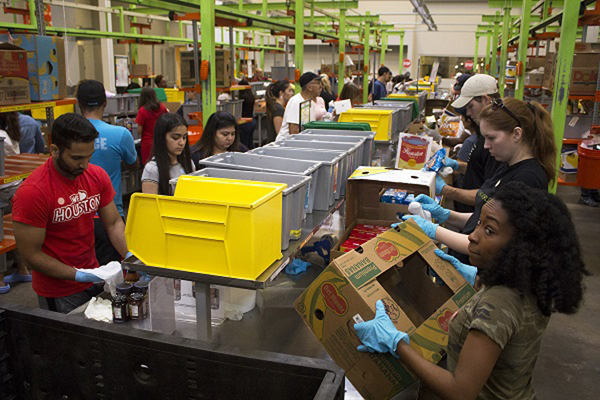- South Texas Students Meet Accordion Music Icons Los Tigres Del Norte In Edinburg Thanks To Khs America/Hohner Alianza Académica Initiative
- Fragile Planet Offers a Nighttime Wildlife Experience
- Falcons Soccer Off & Running
- Cameron County Receives Funds to Improve Two Parks
- Falcons Complete First Half of 32-6A
- School District to Help out Victims of California Wildfires
- Sand Castle Days Continued Despite Unexpected Weather
- Ready for District
- Discussion of Garbage Dumpster Rates, Agreements Between State & City on Highway Regulations, and More
- 31st Annual Shrimp Cook-Off is Right Around the Corner
Food Banks: Harvey Victims May Need Help for Year or Longer
- Updated: October 6, 2017

Houston Food Bank officials say their volunteers have processed and distributed more than 1.5 million pounds of food since Hurricane Harvey. Photo: Houston Food Bank
by Mark Richardson
HOUSTON – After the initial influx of food and other donations following Hurricane Harvey, southeast Texas food banks are preparing to serve the region’s long-term needs.
While most of the emergency shelters have cleared out, thousands of people returned to flood-damaged or destroyed-homes, or lost their jobs and need help putting food on the table. Brian Greene, president of the Houston Food Bank, one of several in the 39-country region affected by the storm, said food banks may need to provide food assistance for many thousands of flood victims for as long as a year or more.
“We have been distributing through a network of about 270 partner distribution sites that agreed to step up and help the people in their neighborhoods,” he said. “The immediate aftermath has been extremely busy, so our challenge is going to be sustainability.”
Greene said his and other food banks normally receive food donations from grocery stores or food distributors. After Harvey, he said, trucks began arriving from all over the country with food and other supplies. He said he expects the challenge will be that as the level of donations taper off, the need for food assistance across the region will remain high.
Because the storm damaged neighborhoods in all parts of the region, Greene said, they find that people from all walks of life need assistance.
“In the middle of the storm and immediately after, you literally could have a person whose net worth is over $1 million sharing space in a shelter with a person who previously was out on the street,” he said. “So, we can be serving people that never would have guessed they’d be needing help from a food bank.”
While his organization is grateful to the people and groups who donate food or clothing to the relief operations, Greene said, the best way to help is through cash donations.
“There’s the Harvey Relief Fund that the mayor and the county judge set up, United Way – these funds are probably the best way,” he said. “They’re learning what the needs are of the different organizations in the community. Money is the best way, but that doesn’t necessarily mean you have to pick one charity to do that.”
Several other state, federal and local government agencies are providing food assistance, including emergency food stamps, or D-SNAP benefits. The Federal Emergency Management Agency has estimated that about 450,000 people in the affected areas will need disaster assistance.
Background on food banks is online at fabackup.feedingamerica.org.
